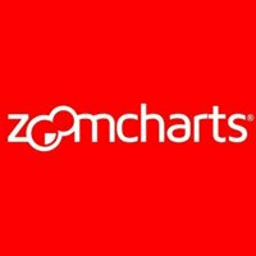
![]()
ZoomCharts
Creating meaningful and aesthetically pleasing data visualizations and incorporating them into your projects is easy with the tools offered by ZoomCharts.
Alternatives to ZoomCharts
Missing a software in the list? We are always happy if you help us making our site even better.
ZoomCharts Reviews
We have 1 review for ZoomCharts. The average overall ratings is 4.0 / 5 stars.
Overall Opinion: Getting access to raw data is easier than it's ever been. Whether you're relying on automated surveys, data scraping software, or sales numbers, there are countless tools at your disposal to get what you need. In a world where data exists in such abundance, it can sometimes become easy to get lost in the roughage. DataZoom helps you take the raw data available to you and to translate it into appealing visuals that will help you communicate the information behind the numbers. With DataZoom's tools, you can more easily convey the right message to your clients or partners and create visualizations that can help you find patterns in your data that you might not otherwise even consider. The best thing about ZoomCharts is that it doesn't require an understanding of code. Data scientists use a countless selection of language to do their job, but JavaScript is well regarded as a means for conveying data in web applications because of its prevalence in web design and its complementary relationship with HTML and CSS. ZoomCharts is built off JS, and it implements its own selection of JavaScript libraries that serve as the core for its wide variety of chart options. The process of transforming raw data from a list of numbers into a colorful and meaningful visualization is simple. You can either preload the data yourself or import it from an SQL or NoSQL database. ZoomCharts will process the information and reformat it to match a chart of your designation. You'll be provided with the code you need to integrate the final results into your web application, at which point it's as easy as cutting and pasting it directly into your project's existing code. One of the perks of using ZoomCharts as opposed to the competition is the native interactivity available in their selection of charts. Their visualizations are primarily designed for use in dashboards, allowing information to be mixed and matched in a central hub and manipulated according to the whims of the user. As such, they take a streamlined approach to their visualizations that allow them to be navigated and explored with clicks and swipes. This functionality is customizable as well. Underlying the charts utilized by ZoomCharts is a system of nodes which designers can expand and manipulate at their whims. You can set the terms for how the user interacts with these nodes to create charts that are as dynamic as your personal or professional needs. Functionality is available for both touch screen and mouse-enabled devices. There's a vast amount of charts available, and their utility makes them sensible for consumers working in a variety of different fields. From classic bar and line graphs that can be used to track sales numbers and other linear variables to bubble maps and flow charts that allow for more densely calculated aggregations of information, ZoomCharts keeps all the necessary bases covered.
Pros: Easy setup and integration with SQL servers Great flexibility when setting up chart interactivity Clean and colorful GUI design
Cons: Rather expensive, especially for individual developers and small teams Only available through subscription service
Features
ZoomCharts Videos
Presentation about data visualization using ZoomCharts and Clusterpoint. Read more about zoomcharts: zoomcharts.com Read more about clusterpoint: http://clusterpoint.com/
Comments
About This Article
This page was composed by Alternative.me and published by Alternative.me. It was created at 2018-04-28 21:21:09 and last edited by Alternative.me at 2020-03-06 07:50:15. This page has been viewed 5363 times.